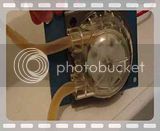cooperplace
Well-Known Member
- Joined
- 24/12/03
- Messages
- 130
- Reaction score
- 6
Thats the response I hope to get. I have tried a 9V battery on the normally open one in reverse polarity, but not 12V. The normally closed one needed 12V to actuate open, but got a sililar bore. I have pushed it as far as she'll go sir, I can not push it anymore.
HI Bandito,
Glad to see this is still happening. Don't take too much notice of the people who tell you that you MUST do it their way! I don't think it really matters whether this project goes to fruition, we can all learn learn something along the way. Good luck.












